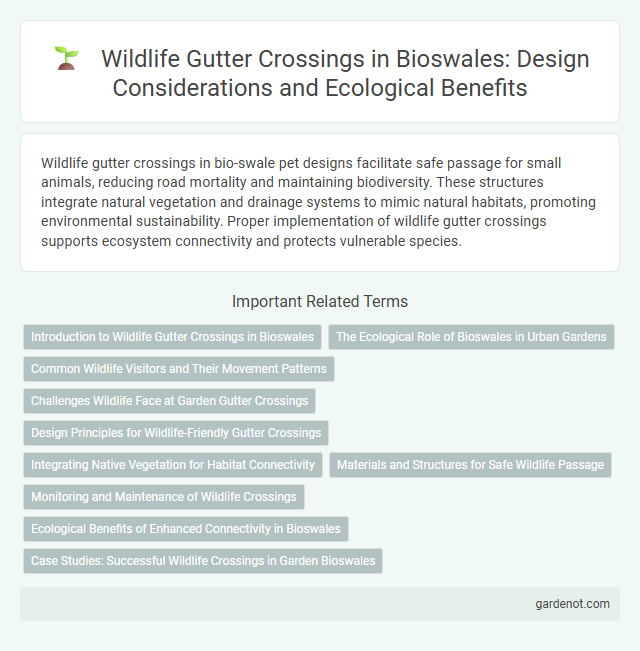Wildlife gutter crossings in bio-swale pet designs facilitate safe passage for small animals, reducing road mortality and maintaining biodiversity. These structures integrate natural vegetation and drainage systems to mimic natural habitats, promoting environmental sustainability. Proper implementation of wildlife gutter crossings supports ecosystem connectivity and protects vulnerable species.
Introduction to Wildlife Gutter Crossings in Bioswales
Wildlife gutter crossings in bioswales provide critical pathways for small animals and amphibians to safely navigate urban environments while maintaining natural hydrological processes. These structures integrate vegetation and permeable materials, reducing stormwater runoff and enhancing habitat connectivity. Incorporating wildlife crossings into bioswales supports biodiversity and mitigates road mortality by facilitating safe animal movement across urban landscapes.
The Ecological Role of Bioswales in Urban Gardens
Bioswales in urban gardens serve as critical wildlife gutter crossings by filtering runoff and creating interconnected green corridors that support biodiversity. Their vegetated channels reduce pollution, improve water infiltration, and provide habitat for small mammals, amphibians, and pollinators navigating urban landscapes. Incorporating native plants enhances these ecological functions, fostering resilient urban ecosystems and promoting wildlife movement amidst city infrastructure.
Common Wildlife Visitors and Their Movement Patterns
Common wildlife visitors to bio-swales include amphibians, small mammals, and reptiles that utilize these corridors for safe movement across urban landscapes. Species such as frogs, salamanders, raccoons, and turtles follow moisture gradients and vegetation cover within bio-swales, facilitating migration and access to feeding and breeding grounds. Understanding these movement patterns helps optimize bio-swale design to enhance habitat connectivity and reduce road mortality.
Challenges Wildlife Face at Garden Gutter Crossings
Wildlife gutter crossings in garden settings often pose significant challenges such as habitat fragmentation and risk of injury due to narrow or steep gutters designed without ecological considerations. These artificial barriers disrupt natural movement, limiting access to food, mates, and shelter, which elevates stress and mortality rates among local species. Implementing bio-swales with gentle slopes, native vegetation, and wildlife-friendly materials can mitigate these impacts, promoting safer and more effective wildlife passage.
Design Principles for Wildlife-Friendly Gutter Crossings
Wildlife-friendly gutter crossings prioritize natural habitat connectivity by incorporating gentle slopes and textured surfaces that facilitate animal movement across urban drainage barriers. Vegetation integration within gutters enhances cover and mimics natural environments, encouraging safe passage for small mammals and amphibians. These design principles reduce habitat fragmentation while maintaining effective stormwater management in bio-swale systems.
Integrating Native Vegetation for Habitat Connectivity
Integrating native vegetation into wildlife gutter crossings enhances habitat connectivity by providing continuous, natural corridors that support local fauna movement and biodiversity. Native plants help stabilize soil, filter runoff, and create suitable microhabitats that encourage species usage of these passages. Effective bio-swale designs prioritize indigenous flora to maintain ecological balance and promote seamless wildlife migration across fragmented landscapes.
Materials and Structures for Safe Wildlife Passage
Wildlife gutter crossings in bio-swales utilize durable, non-toxic materials such as permeable concrete, recycled rubber, and galvanized steel to ensure longevity and environmental safety. Structures often incorporate raised, vegetated channels and strategically placed wildlife ramps to facilitate natural animal movement while preventing waterborne hazards. These engineered systems optimize habitat connectivity and reduce road mortality by mimicking natural waterways and providing secure, accessible passage for diverse species.
Monitoring and Maintenance of Wildlife Crossings
Monitoring and maintenance of wildlife gutter crossings ensure the effective movement of animals and reduce road mortality by regularly inspecting habitat connectivity and structural integrity. Advanced remote sensing and camera trap technologies facilitate continuous observation of animal usage patterns and identify potential blockages or damages. Routine maintenance involves clearing debris, repairing erosion, and managing vegetation to optimize safe passage and ecological functionality within bio-swale systems.
Ecological Benefits of Enhanced Connectivity in Bioswales
Wildlife gutter crossings integrated into bioswales significantly enhance ecological connectivity by providing safe passageways for animals across urbanized areas, reducing road mortality and habitat fragmentation. These structures facilitate natural movement patterns, allowing species to access diverse habitats essential for foraging, breeding, and shelter, which promotes biodiversity. Improved connectivity through bioswale designs supports ecosystem resilience and sustains local wildlife populations in rapidly developed environments.
Case Studies: Successful Wildlife Crossings in Garden Bioswales
Garden bioswales with integrated wildlife gutter crossings have demonstrated significant success in promoting safe animal movement while managing stormwater effectively. Case studies from urban areas reveal that these bio-swales reduce roadkill incidents by channeling small mammals, amphibians, and reptiles across streets through vegetated corridors linked to underground gutters. Enhanced biodiversity and improved ecological connectivity were observed in multiple projects where native plants and permeable materials supported natural habitats alongside water filtration functions.
Wildlife gutter crossing Infographic

 gardenot.com
gardenot.com